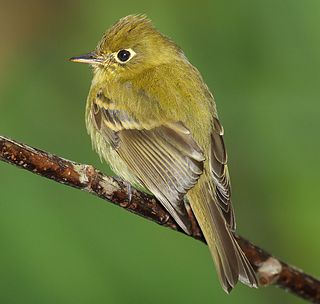
The tyrant flycatchers (Tyrannidae) are a family of passerine birds which occur throughout North and South America. They are considered the largest family of birds known to exist in the world, with more than 400 species. They are the most diverse avian family in every country in the Americas, except for the United States and Canada. The members vary greatly in shape, patterns, size and colors. Some tyrant flycatchers may superficially resemble the Old World flycatchers, which they are named after but are not closely related to. They are members of suborder Tyranni (suboscines), which do not have the sophisticated vocal capabilities of most other songbirds.

The Tyranni (suboscines) are a suborder of passerine birds that includes more than 1,000 species, the large majority of which are South American. It is named after the type genus Tyrannus.

Tyrannus is a genus of small passerine birds in the tyrant flycatcher family Tyrannidae that are native to the Americas. The majority are named as kingbirds.

Anselme Gaëtan Desmarest was a French zoologist and author. He was the son of Nicolas Desmarest and father of Eugène Anselme Sébastien Léon Desmarest. Desmarest was a disciple of Georges Cuvier and Alexandre Brongniart, and in 1815, he succeeded Pierre André Latreille to the professorship of zoology at the École nationale vétérinaire d'Alfort. He was elected to the American Philosophical Society in 1819 and to the Académie Nationale de Médecine in 1820.

Euphonias are members of the genus Euphonia, a group of Neotropical birds in the finch family. They and the chlorophonias comprise the subfamily Euphoniinae.

The white-throated spadebill is a tiny passerine bird in the tyrant flycatcher family. It lives in the tropical Americas.

Described by French naturalist Anselme Gaëtan Desmarest in 1826, the genus Calyptorhynchus has two species of cockatoos. They are all mostly black in colour, and the taxa may be differentiated partly by size and partly by small areas of red, grey, and yellow plumage, especially in the tail feathers. Studies based on the mitochondrial DNA 12S gene fragment suggested that other sexually dichromatic species, the gang-gang cockatoo and the cockatiel may be the closest living relatives of Calyptorhynchus. However, subsequent studies, including more genes confirm the morphological taxonomy with the gang-gang cockatoo most closely related to the galah, within the white cockatoo group, and with the cockatiel as a third distinct subfamily of cockatoos.
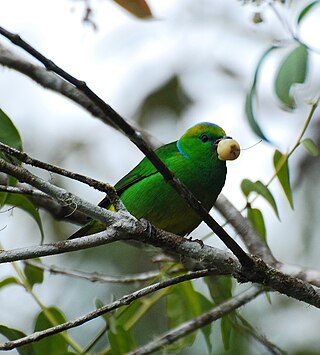
Chlorophonia is a genus of finches in the family Fringillidae. The Chlorophonias are endemic to the Neotropics. They are small, mostly bright green birds that inhabit humid forests and nearby habitats, especially in highlands.

The purple-throated euphonia is a songbird species in the family Fringillidae. It was formerly placed in the Thraupidae.
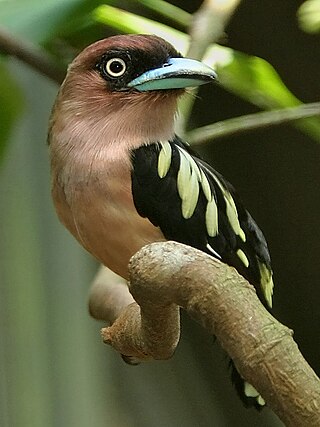
Eurylaimus is a genus of broadbills found in Southeast Asia.

Knipolegus is a genus of birds, the black tyrants, in the tyrant flycatcher family Tyrannidae.
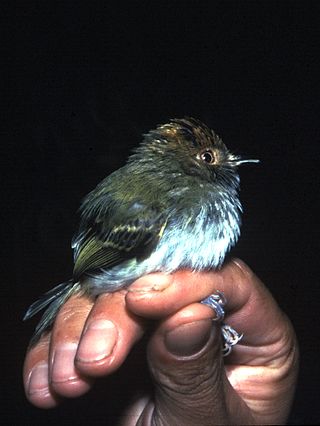
Lophotriccus is a genus of South American birds in the tyrant flycatcher family Tyrannidae.

McConnell's flycatcher is a species of bird in the tyrant flycatcher family Tyrannidae. It is found in the Guiana Shield, northern Brazil, Peru and Bolivia. Its natural habitats are subtropical or tropical moist lowland forests and subtropical or tropical moist montane forests.

Phyllomyias is a genus of small birds in the tyrant-flycatcher family Tyrannidae. They are found in wooded habitats of Central and South America. Some species are among the commonest birds in their range, while other are rare and threatened. They have a short, stubby bill, are greenish above, yellowish or whitish below, and all except the sooty-headed tyrannulet have pale wing-bars or edging. They feed on small arthropods and fruits. Most species regularly take part in mixed species flocks.
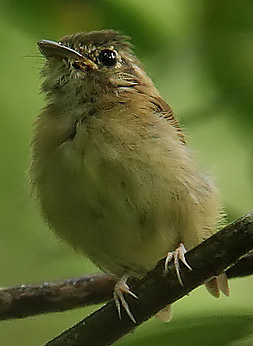
The stub-tailed spadebill is a passerine bird in the Tyrannidae family. It is commonly found in tropical dry rainforests or tropical moist lowlands throughout Central America. First scientifically described in 1860, it was originally thought to be the same as Platyrinchus mystaceus but was later reclassified as a sympatric species. The stub-tailed spadebill may grow up to 9.5 cm (3.74 in) long and may weigh up to 12 g (0.42 oz). It has a white throat, yellow breast, and brown mantle and wings. The stub-tailed spadebill is most easily recognizable due to its stubby tail, broad bill, and its distinctive bird song. Some morphological differences like its greatly reduced crown differentiate it from other related species.

The white-crested spadebill is a species of passerine bird in the tyrant flycatcher family Tyrannidae. It is found in Bolivia, Brazil, Colombia, Ecuador, French Guiana, Guyana, Peru, Suriname, and Venezuela. Its natural habitat is subtropical or tropical moist lowland forests.

The Brazilian tanager is a species of bird in the family Thraupidae. It is endemic to eastern Brazil and far northeastern Argentina, occurring in the coastal region from Paraíba and southwards to Santa Catarina and Misiones.

Tolmomyias is a genus of Neotropical birds in the tyrant flycatcher family Tyrannidae. It is one of the two genera containing the "flatbills"; the other is Rhynchocyclus.

Lessonia is a genus of South American birds in the tyrant flycatcher family, found near freshwater lakes and saline marshes.

Ramphocelus is a Neotropical genus of birds of the tanager family. They have enlarged shiny whitish or bluish-grey lower mandibles, which are pointed upwards in display. However, this is greatly reduced in the females of most species. Males are black and red, orange or yellow, while females resemble a duller version of the males, or are brownish or greyish combined with dull red, orange or yellowish.


























